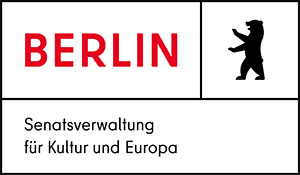30 April–14 August 2021
Artists
Project group station urbaner kulturen
Juan Camilo Alfonso Angulo, Jochen Becker, Fabian Bovens, Eva Hertzsch, Margarete Kiss, Constanze Musterer, Adam Page
Arne Schmitt. Photography, Video, Text
The artist Arne Schmitt, who works with photography and video, is mainly active in western Europe, where he studies what Benedikt Boucsein has called the »grey architectures«. His often black-and-white pictures are enlightened statements on a world of consumer zones, administrative units and educational landscapes. Appearing as obsolete models of post-war modernism, coupled with a city built for cars, they nonetheless come back to life again and again. Rather than celebrating the buildings and urban formations, Schmitt extracts from their roughness what the caring modernism of capitalist welfare states has left behind.
Schmitt’s memories, that reach right up to the present, portray a built and (in the videos) lived desire to create a better world. Partial failure is inscribed in the work, but hope is not entirely written off. As a well-read and fascinated observer, he roams through a built environment full of ideas and intentions that he captures with its people, cars, vegetation and signage. The video medium helps to make sense of its more sobering aspects. Schmitt’s archaeology of the recent past, as it has become set in stone, does not abandon the idea of an urban society. But: »The sale must go on.«
The idea of an active minority
»One is aware that, all in all, a minority is at work here. But that has always been the case. Except that this minority is effective, articulate. They are zealots. And the ideas they proclaim to the majority are not flights of fancy. And people listen.« Cees Nooteboom on May 68 in Paris
The open conflict fought out between students and the state in the stone centre of the European city, a conflict that intermittently activated large sections of the population, had its beginnings on the outskirts of Paris, on the modern university campus at Nanterre. In Bordeaux, too, the first student protests took place in the halls of residence on the extensive suburban university campus that had been built since the 1950s. In 1968, only the humanities were still in the city centre, becoming the headquarters of the student movement. After the end of the unrest, the responsible prefect called for the faculty to be relocated to the periphery as quickly as possible.
There is a wealth of links here between centralism and marginalisation, between urban planning and technocratic control of society. Active minorities often intervene from the margins – but the path to the centre must be taken if lasting change is to be achieved. The same applies for the more recently contested terrain that opens up between language, thought and action.
Students in Berlin-Hellersdorf publicly criticized a poem that had been applied to one of the façades of their university on the orders of its directors. The students demanded to be consulted, proceeding democratically through all of university’s administrative committees – and achieved change. A majority within politics and society, characterized above all by superior power, was so outraged by this as to call for an authoritarian intervention – often with reference to their own values as members of 1968 generation. Their complaint: the students were only speaking for a minority.
In the context of this debate, what does it mean that this outraged majority had hardly ever seen the façade in question close up, nor the part of Berlin where it stands? And how does the non-university neighbourhood see the façade - as its most frequent group of viewers?
Arne Schmitt
Events:
Friday, 30 April 2021, 19:00 (de)
Online talk ›Mediations‹ Arne Schmitt mit Volker Pantenburg
Volker Pantenburg teaches film history at the Freie Universität Berlin and is co-founder of the Harun Farocki Institute. His focus is critical film practice, from Godard to Farocki. He will adress the specifics of documentary, artistic and essay film in conversation with Arne Schmitt.
Friday, 18 June 2021, 19:00 (de)
Online talk and film screening ›Re/Education‹ with Simone Hain, Andrea Plöger, Arne Schmitt, Fari Shams
Simone Hain (author of ›Die Salons der Sozialisten‹) and Andrea Plöger (Professor Alice Salomon Hochschule Hellersdorf) will discuss educational policy in the East and the West. They will also refer to the denazifying and emancipating forms of practical »re-education«. The recent dispute about a mural at the Alice Salomon Hochschule with a text by Eugen Gomringer is an example of the struggles of critical practice and (self-)education within educational institutions, this time in Hellersdorf itself.
The video ›die insel‹ by Fari Shams & Arne Schmitt about adult education and post-war modernism in the town of Marl will be put online to compliment the discussion and will be screened on site.
Fari Shams & Arne Schmitt
»die insel« (70 min.)
German with english subtitles
2020
Saturday, 26 June 2021, 16:00 (de)
Online talk ›Educational institutions‹ with Sabine Bitter/Helmut Weber/Klaus Ronneberger, Eva Hertzsch/Adam Page, Tom Holert
The artists Bitter/Weber (Vienna/Vancouver) and the urban researcher Klaus Ronneberger (Frankfurt/M.) accompanied the relocation of Frankfurt University to the site of the former IG-Farben-Haus. The campus, once built in an anti-fascist esprit, was then partially demolished.The university‘s move to a building with an authoritarian architecture is symptomatic of its need to assert itself on today‘s education market.
Tom Holert is curator of the exhibition »Bildungsschock. Learning, Politics and Architecture in the 1960s and 1970s« at Haus der Kulturen der Welt. The show critiques the international euphoria surrounding the »education offensive« of the time. As part of »Bildungsschock«, Hertzsch/Page (co-founders of station urbaner kulturen) produced an artwork with pupils at Walter-Gropius-Schule on the Gropiusstadt housing estate.
Financed by

